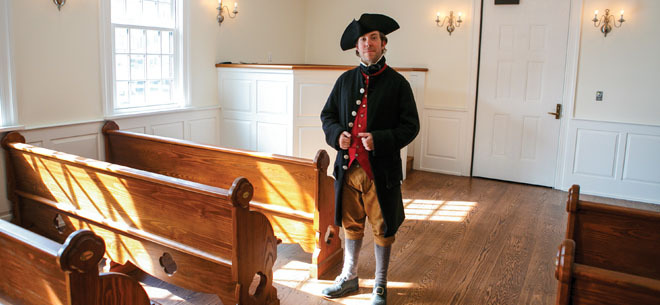Son of Liberty

Most of us know Samuel Adams from high school history class—or, at the very least, as the face of the popular Boston-based beer. But Adams is also alive and well at the Boston Tea Party Ships & Museum, regularly reenacting the momentous night of December 16, 1773 with the help of Boston’s visitors.
For those needing a recap: In 1773, the Boston public was restless due to what they perceived as unfair taxation policies, particularly on tea. On the night of December 16, thousands of Bostonians crowded into the Old South Meeting House to discuss the situation. After receiving a report that the protesters’ final request for a peaceful resolution was refused by local authorities, Adams stood up and said, “This meeting can do nothing more to save the country.” This statement was actually a code that Adams, the leader of the Sons of Liberty, was sending to signal them to dump the tea in the harbor.
This event was one of the first forms of peaceful protest in the Americas. No one was harmed and the Sons of Liberty were meticulous about keeping the event civil. They even went back the next morning to replace a lock they broke.
In the present day, Adams keeps this important piece of history alive. “What happened in these waters was the catalyst for the American Revolution and it deserves to be remembered and celebrated,” he says. At the museum, visitors get a character card describing a real person who participated in the event and play that role for the rest of the tour. A guide, whether Sam Adams, John Adams, Paul Revere, John Hancock or one of many others, takes them through the ship and explains the story of the Boston Tea Party. Then they relive history by throwing the tea overboard.
The experience involves a lot more than tossing tea. “The highlight is showing the Robinson half chest, which is one of only two remaining chests of tea from that night in 1773,” proclaims Adams. That’s some serious history.
After doing so many tours, Adams would like to set the record straight about a few misconceptions. “Famous drawings often show patriots totally disguised as Mohawk Indians. This is completely incorrect,” he clarifies. The patriots disguised themselves with blankets and soot; the few feathers they wore were meant as symbols of independence and autonomy, not to be mistaken for Native Americans.
When asked how he feels about the beer named after him, Adams laughs. “I actually don’t drink any alcohol.” Ironically enough, Adams does love to drink tea. Too bad he had most of it thrown overboard.


